Ukrainian partisan resistance to Russia’s occupation forces has intensified significantly in the last 10 days, August 4-13. In my last update, which encompassed 28 days, July 6-August 2, I noted 33 resistance incidents, of which 17 were non-violent and 16 were violent, being directed at persons or property. That comes out to 1.18 incidents per day.
In marked contrast, the last 10 days have witnessed 34 resistance incidents, of which 12 were non-violent and 22 were violent, with 13 being directed at property and nine at persons. That comes out to 3.4 incidents per day, almost a threefold increase over the last reporting period.
No less important, whereas non-violent incidents represented 0.52 percent of the total in July 6-August 2, they dropped to 0.36 percent in the last 10 days. Unsurprisingly, most of the partisan activity is in Kherson and Zaporizhzhya provinces; importantly, a resistance movement appears to have also emerged in occupied Crimea.
The evidence speaks for itself: the Ukrainian guerrilla struggle is intensifying and becoming decidedly more violent.
August 4, Bilovodsk, Luhansk province: partisans shoot at a car carrying collaborators, Vitaly Kovalenko, Bilovodsk district head, and his deputy, Valentyna Hladkova. Both are wounded.
August 4, Melitopol, Zaporizhzhya province: anti-Russian leaflets distributed in mail boxes.
August 4, Kherson: collaborationist Kherson province governor, Volodymyr Saldo (the target of a failed assassination attempt on July 11), falls into coma and is hospitalized in Moscow. Doctors suspect Saldo was poisoned.
August 5, Melitopol, Zaporizhzhya province: pro-Ukrainian slogans appear in the city center.
August 5, Vovchansk, occupied Kharkiv province: pro-Ukrainian leaflets appear in the city.
August 6, Nova Kakhovka, Kherson province: collaborationist deputy head of local administration, Vitaly Hura, shot and killed.
August 6, Tokmak, Zaporizhzhya province: partisans blow up rail line.
August 6, Kherson: Yellow Ribbon resistance movement distributes first issue of underground gazette, Voice of the Partisan. Print run: 1,200.
August 6, Berdyansk, Zaporizhzhya province: the Berdyansk Partisan Army stages explosion near the city police department.
August 8, Berdyansk: explosion near the home of collaborationist deputy mayor, apparently, the work of the Berdyansk Partisan Army.
August 8, Kherson: leaflets appear in the city threatening the poisoned Volodymyr Saldo’s successor as collaborationist Kherson province governor, Kyrylo Stryemousov, with the same fate.
August 8, Beryslav, Kherson province: graffiti appears announcing that the Ukrainian armed forces are “already here” and that “Putin is a prick.”
August 9, Simferopol and Alushta, occupied Crimea: partisans declare a $230,000 bounty on Sergey Aksyonov, head of the self-styled republic.
August 9, Melitopol, Zaporizhzhya province: partisans paste leaflets asking for information about the location of voting stations for Russia’s planned “referendum.”
August 9, Melitopol: partisans set off explosion near United Russia headquarters in the city center.
August 9, Kherson: partisans distribute leaflets dissuading people from accepting Russian passports and taking part in the referendum.
August 9, Saki air base, occupied Crimea: multiple explosions with possible involvement of local partisans.
August 10, Mariupol, Donetsk province: explosion in city center, possibly the work of local partisans.
August 10, Melitopol, Zaporizhzhya province: partisans kill two collaborators involved in preparing the “referendum.”
August 11, Kherson: pro-Ukrainian leaflets appear in the city.
August 11, Kherson province: pylon supporting power line leading from Zaporizhzhya Nuclear Power Plant to occupied Crimea collapses, possibly due to partisan activity.
August 11, Starobilsk, Luhansk province: partisans explode car driven by a collaborator who heads the Interdistrict Registration and Examination Department.
August 11, Lysychansk, Luhansk province: leaflets appear threatening collaborators (in particular, one Andriy Skoryy) with death.
August 12, Melitopol, Zaporizhzhya province: explosion in yard off Hohol Street. Target was Oleh Shostak, collaborationist head of the propaganda division of local United Russia electoral command. Shostak was hospitalized.
August 12, Kherson: leaflets warning that “the Russian passport kills” appear in the city.
August 13, Melitopol, Zaporizhzhya province: partisans set off explosions in the northeastern part of the city. Target: military building occupied by Russian troops.
August 13, Kherson province: multiple explosions in Chkalov, Novotroyitske, Chaplynka, Nyzhni Sirohozy, Velyka Blahovishchenka, and Nova Kakhovka.
August 13, Mariupol, Donetsk province: powerful explosion in city.
There is no reason to think that the resistance will wane anytime in the near future. Quite the contrary, it is sure to grow and become even more violent—especially if the Ukrainian armed forces continue to press the Russians in the south and keep them from advancing in the east.
Expert Biography: Now a 1945 Contributing Editor, Dr. Alexander Motyl is a professor of political science at Rutgers-Newark. A specialist on Ukraine, Russia, and the USSR, and on nationalism, revolutions, empires, and theory, he is the author of 10 books of nonfiction, including Pidsumky imperii (2009); Puti imperii (2004); Imperial Ends: The Decay, Collapse, and Revival of Empires (2001); Revolutions, Nations, Empires: Conceptual Limits and Theoretical Possibilities (1999); Dilemmas of Independence: Ukraine after Totalitarianism (1993); and The Turn to the Right: The Ideological Origins and Development of Ukrainian Nationalism, 1919–1929 (1980); the editor of 15 volumes, including The Encyclopedia of Nationalism (2000) and The Holodomor Reader (2012); and a contributor of dozens of articles to academic and policy journals, newspaper op-ed pages, and magazines. He also has a weekly blog, “Ukraine’s Orange Blues.”

